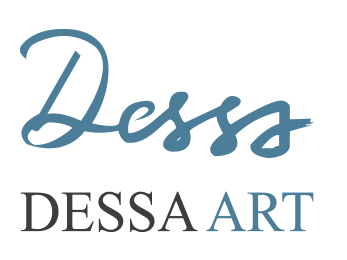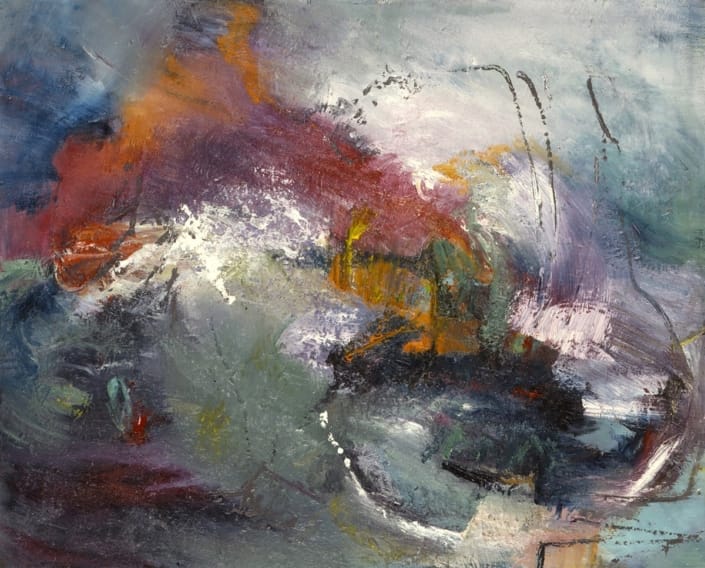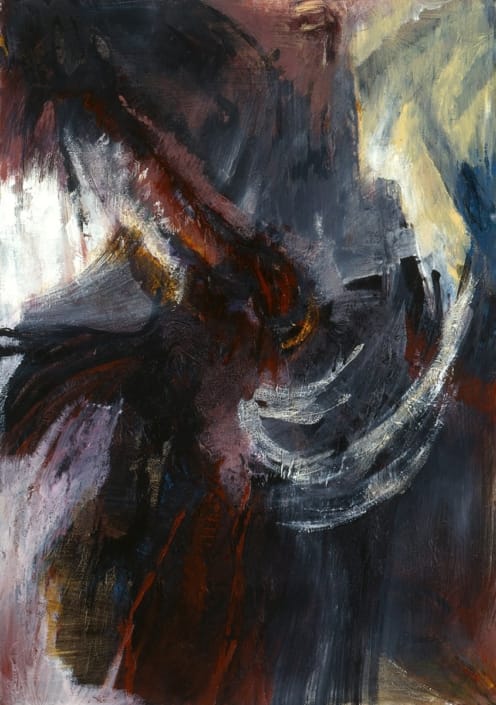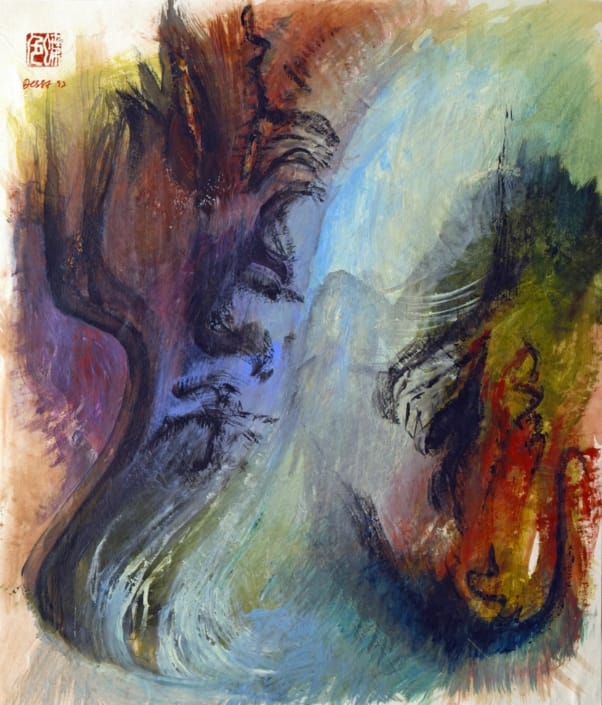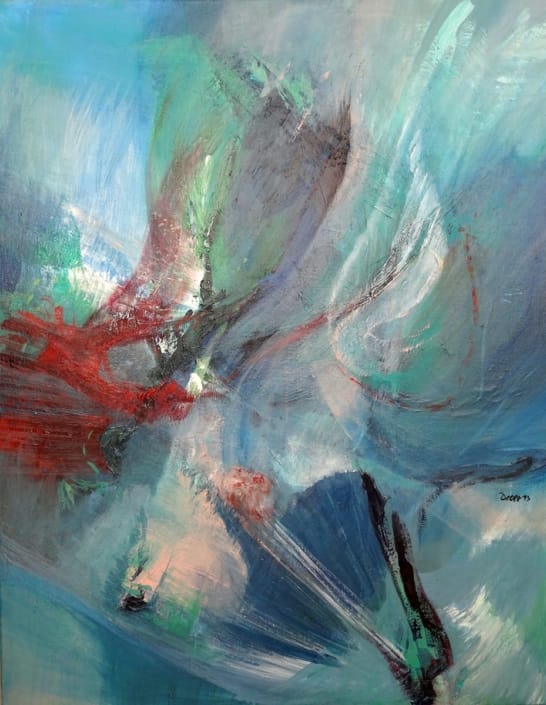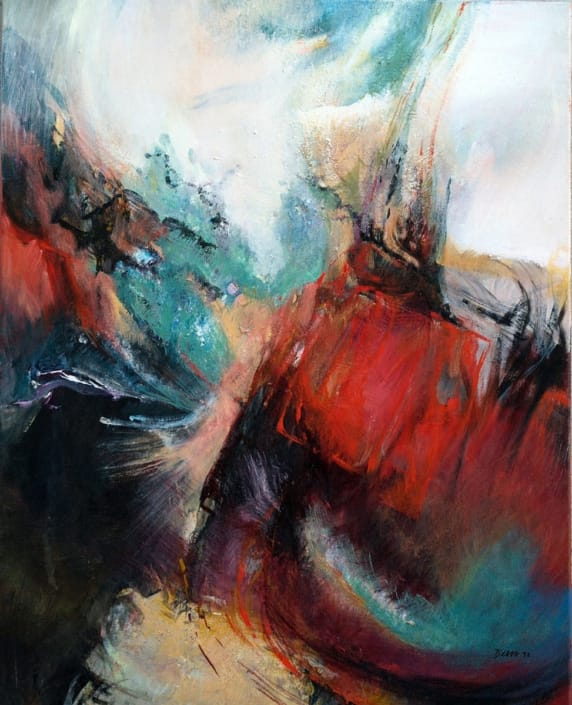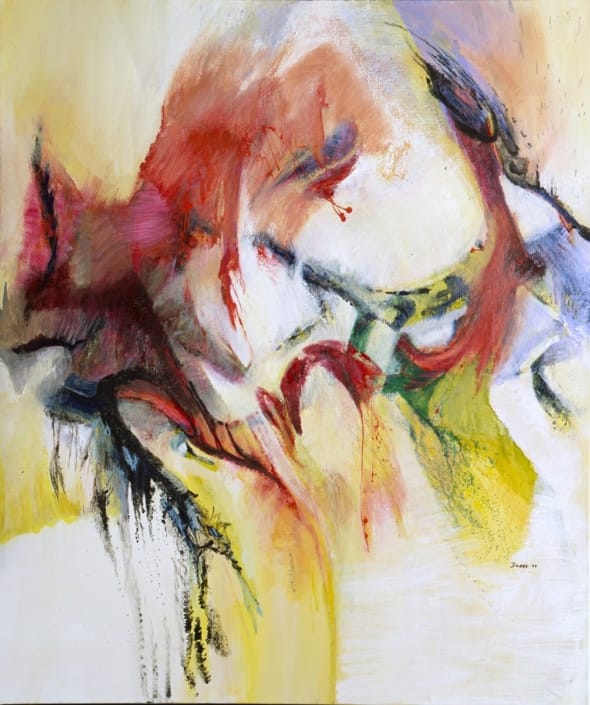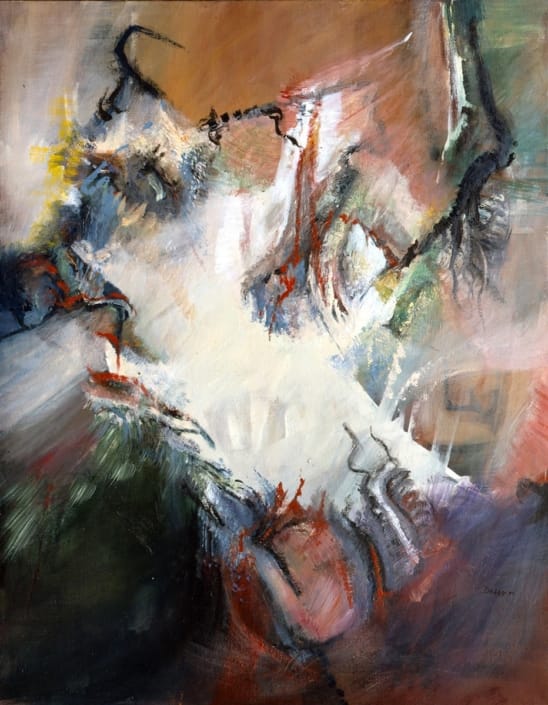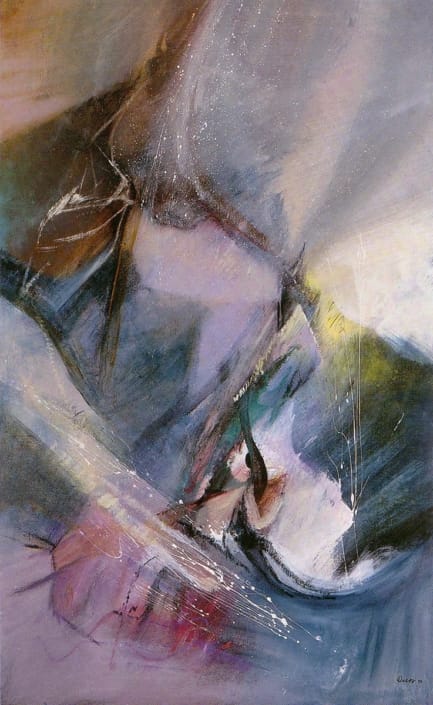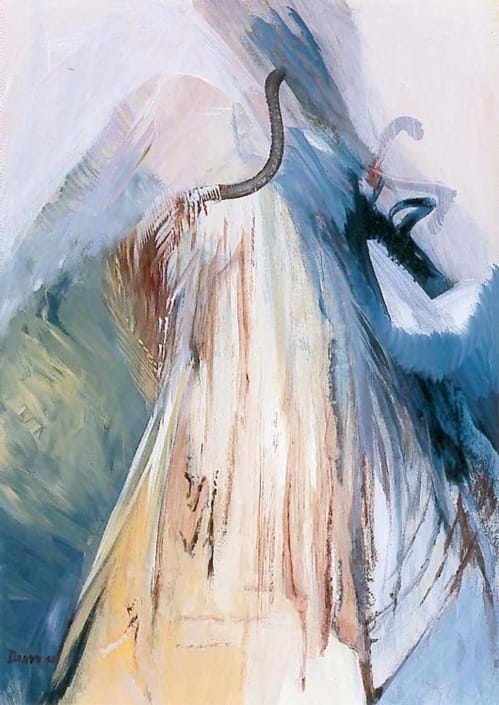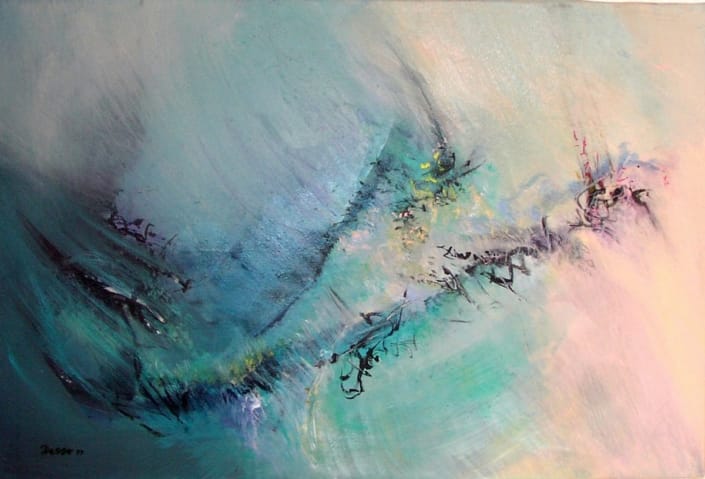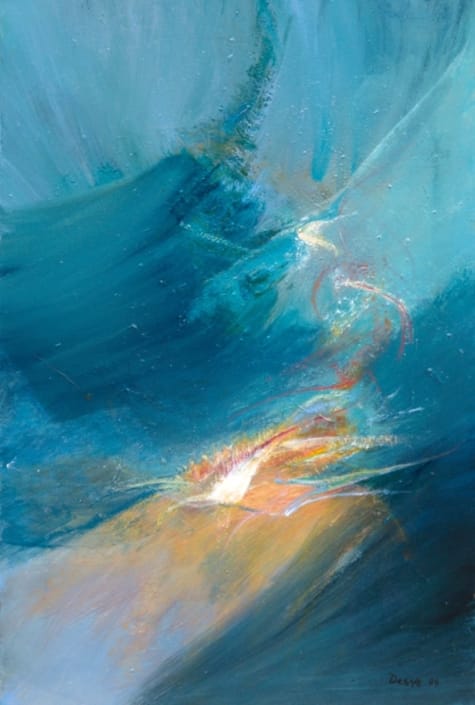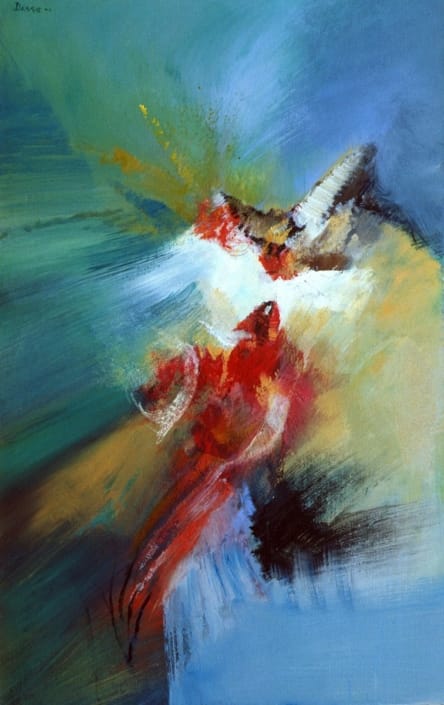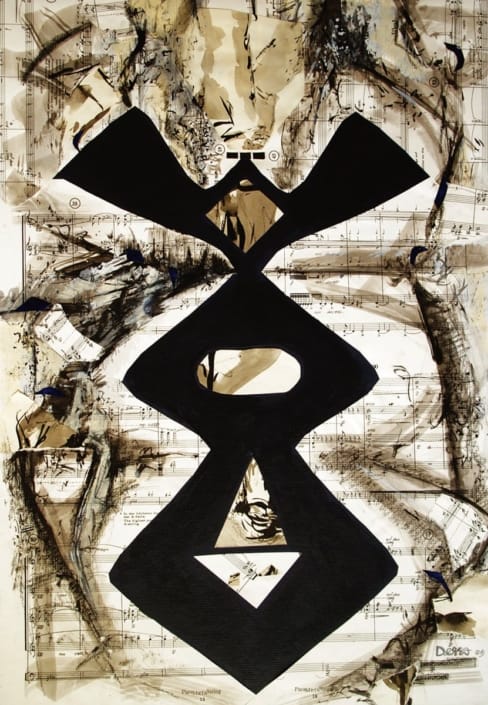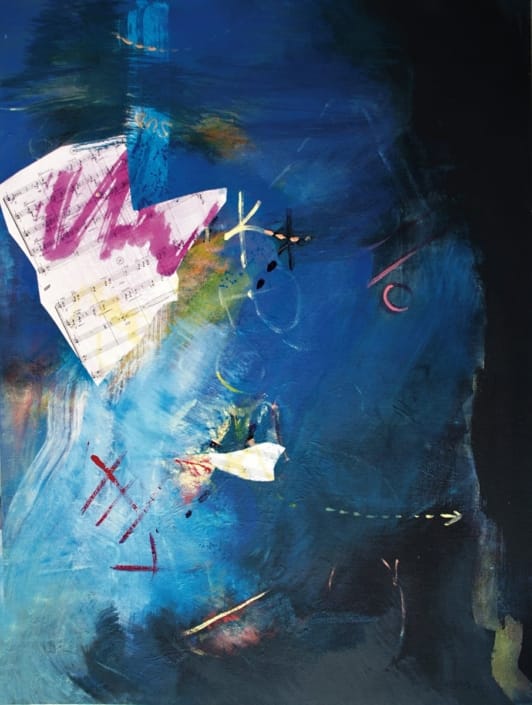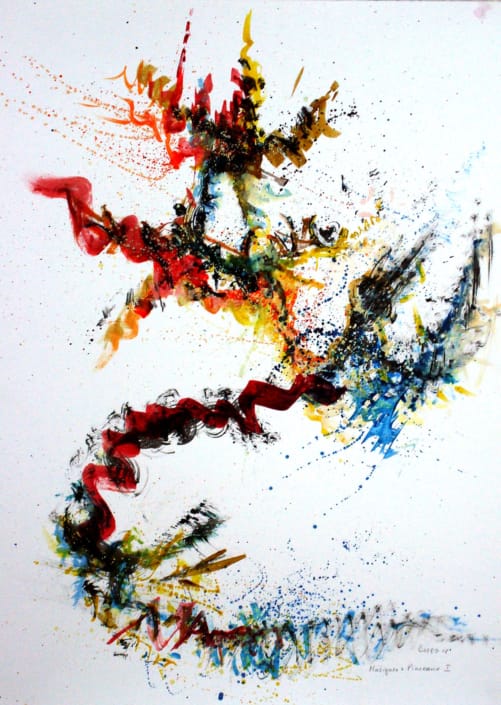Abstracts
Introduction to My Approach to Painting from Music
“I have never met an artist for whom another artistic discipline other than her own, can have such an importance, as for Dessa. This must be emphasized, because all the specificity and singularity of her creation lies within this phenomenon. The music is not only a stimulation, or source of inspiration, it is almost the condition « sine qua non » to awake, and to nourish her creative spirit.
Preceding Dessa’s creation is a gesture of open-mindedness, mental liveliness, her natural ability for communication, permeability and also vulnerability. It is a purely total musical attitude that puts her in vibration.
To paint is to react with all of her being, not only with the brain and the hand. To paint is to use her body as a receptor that captures the music’s energy before re-coding it into another medium. To paint is to dance.
Dessa’s art works are, in fact, dialogues expressed as paintings. They are dialogues that often resemble spiritual excercises. Because – if they are not in direct communication with a musician like her Transoundart improvisation – they require a lot of solitude, concentration and sacfrifice. With interlocutors such as Mahler, Schreker, Ullmann or Britten one simply cannot discuss. One has to love them, know them well, their ideas, their destiny, their tradegy. Without this, they do not open up to us.”
Frank Harders-Wuthenow, Musicologist, Berlin.
I did not consciously decide one day to work from music, but it is not surprising as music has always been a part of my life. Being able to read music opens one to another world, like knowing another language. I started piano lessons and ballet classes at an early age. In Israel I sang in a choir.
My childhood was filled with different musical styles and I loved the rhythm of African songs and drums. I spent time then, and since, listening to the orchestra of natural sound. Zimbabwe’s rich environment combined bird song with the chirp of crickets and clicking of other insects, the croaking of frogs together with the patter of rain and roar of thunder.
Working with classical compositions over the years has been a learning process, not only about the composer but also how each composition suggests different emotions and ideas, and how my art has consequently responded and developed.
I collaborated with Frank Harders-Wuthenow, the Promotions Executive for the music editors Boosey and Hawkes in Berlin for my last two projects, namely “Composition” – music by Unsuk Chin and by Detlev Glanert and “Do We Smile or Do We Weep?” – music by Benjamin Britten. I was now free to use the written manuscripts as I wished, adding new forms to my music paintings, namely collage. The cuttings of the musical partitions with the notes and the composer’s handwriting brought new dimensions to the art work.
Gustav Mahler – Das Lied von der Erde – 1990
It was this composition of Gustav Mahler which led me to work from music. One evening in 1989, during a radio broadcast of the songs, I was mesmerized, so deeply moved, and said out loud “I have to paint this music”.
More ...
Leonard Bernstein described the composition as Mahler’s greatest symphony – for two voices and orchestra. It is filled with symbols of duality, of both innocence and mortality, illusion and reality. I was familiar with Mahler’s symphonies for orchestra but it was the first time I had heard this composition, transmitting its powerful emotion and ideas.
I began to research Mahler’s life and what he wanted to express in this particular composition, based on Chinese poems, and listened to several interpretations of the songs together with the musical manuscript. The music, always present as I worked, inspired a series of thirty works on canvas, created in a year.
One could say I worked with, and from, the composition. I would absorb information from the music and the music would draw material out from me. Unknowingly it was the start of a working methodology I developed to “recompose” from a piece of classical music of various composers.
Olivier Messiaen – Turangalîla – 1992
„The painting denies its format and its limits. The viewer feels seized, completely taken by the blues, greens, turquoise and emerald, rain pearls, thundering cascades, plunging waterfalls within innermost depths;
More ...
or immersed into dark colouring enhanced by gold or blood suggested by other movements of “Turangalîla”, grottos, secret fissures cut into the deepest earth.
Through shades and forms that she extracts from the music, Dessa, with remarkable freedom of expression, enables one to feel the menacing storm, the ebb and flow of controlled emotion, the elaborate materials and impelled gestures. Together with the storm she presents the gentleness of her creative inspiration”.
Extract from the text „The Colour of Music” by Simon Vermot
Ernest Bloch – Schelomo – 1993
Hebraic rhapsody for cello and orchestra
During the years 1911 to 1926, Ernst Bloch (1880 Geneva – 1959 Oregon, USA) based his inspiration on Jewish themes of important spiritual meaning.
More ...
In this rhapsody, he likened the cello to the voice of Solomon. But the imagery I heard in the music was the exodus from Egypt and crossing to Canaan. My paintings are covered in yellow, browns and reds, others in blues and greens, ochre and red to express the depth of all the powerful emotion. The music touched me deeply, it made me weep. It was a very moving experience.
Chinese music for Er-Hu – 1992
During a previous visit to China I bought an Er-hu with the intention of returning one day to China to learn to play it and paint from music for Er-hu. A few years later I was able to spend two months in Hangzhou, with thanks to Dji-deh, a retired professor of Russian who has since passed away.
More ...
She organized my contacts and meetings with local people and introduced me to Zheng Fang, a traditional Chinese painter and teacher. I brought some art material with me, such as brushes and acrylic paint, and bought Chinese brushes and a special silk for art purposes, with the help of Zheng Fang. Once painted, the silk had to be stretched and glued onto thin paper, and Zheng Fang came regularly to help me do this. He also made me a Chinese stamp to print on each painting.
The Er-hu is similar to the violin but has only two strings and is played with a bow between the two strings. I find its beautiful sound more melancholic than the violin. I had several different tape recordings, some solo Er-hu, and others with orchestra.
Bridging cultures through my art, as a living experience, was particularly rewarding. When I strolled through the streets of Hangzhou I often heard musicians playing traditional music, to the pedestrians. I returned to Hangzhou many years later for a short visit, and along with its fast and furious development, sadly most of the music one heard now on the pavements was popular music from the west, intended to lure people into the modern stores. I asked Zheng Fang how his country would preserve this loss of their own traditional music and his reply was that the museums would conserve it.
Nino Rota – Concerto per archi
Nino Rota is known for his film music, but I chose to work from his concerto for strings. I like the energy and brightness of the music.
Leonard Bernstein – The Age of Anxiety – 1994
More ...
I wanted to work again with music inspired from poetry, like the first project with Mahler’s songs, and thus combining music and poetry with visual art. I chose Bernstein’s second symphony which he titles “The Age of Anxiety”, the title of the poem written in 1947 by W.H. Auden and which inspired Bernstein’s second symphony. The essential theme of the poem, and the music, is man’s search for faith and identity in an ever more industrialized and war- torn world.
Bela Bartok – Concerto for Orchestra
The music of Bartok connects me directly to my Hungarian father. An interesting anecdote, at the exhibition of my Bartok inspired paintings in Basel, a visitor looking at a big tryptic with a dominance of red exclaimed, “ I can smell the paprika!”.
Viktor Ullmann – Piano Sonata No. 7
“With Viktor Ullmann, her work attains an additional dimension, even though she did not realise this immediately: “This music evoked so many images and emotions in me. But I was unaware of what its power would to do to me personally. The story, therefore, goes far beyond the fifteen months of painting necessary to complete the art,” Dessa remembers.
More ...
The story is, indeed, far longer. Dessa was born in Zimbabwe to Polish and Hungarian parents, both Jewish. And her grandparents perished in Auschwitz. Hence, the resonance of the Ullmann trajectory is so profound.
From personal considerations to the duty of remembrance
“A sort of personal therapy, states Dessa. This music made me realise that I had never asked myself certain existential questions. For example, the loss of my grandparents in Auschwitz, what did this do to me? I realise it did a lot, on an unconscious level. The way I grasp the world is printed, in a certain manner, in the history of my people.”
Because beyond oneself, there are the others: “Whilst painting from this music, I was reacting to an inner necessity. I had absolutely no idea of the importance this would present for others. I felt I had a responsibility, not only to Viktor Ullmann, but also to my grandparents and other people”. And Dessa speaks of informing “about those who had the courage and will, in this camp, to continue to create.”
Extract from article in swissinfo/Bernard Léchot «A Legacy from Theresienstadt», at Ghetto Museum of Terezin, from 7 November 2002 to 28 January 2003.
Erich Wolfgang Korngold – Abschiedslieder (Songs of Farewell)
In the biography on Korngold by Jessica Duchen, Phaidon 1996 is written that Korngold composed the music to these four poems at a time when the parents of both families opposed his relationship with Luzi von Sonnenthal. They did marry and had a very good marriage. The songs are beautiful, melodious and very inspiring.
René Oberson – La Porte Mystique
Swiss composer René Oberson composes for the organ, an instrument I was unfamiliar with. His composition opened new doors to my work cycles. I enjoyed working with a living composer and this experience encouraged me to do another project with composers from Berlin.
Composition: Parametastring – Unsuk Chin | Vergessenes Bild – Detlev Glanert
I wanted to do a project in which I work from the music of two living composers. With the collaboration of Frank Harders Wuthenow of Boosey and Hawkes, in Berlin, I was able to meet the composers and given free use of their music.
More ...
Extract of text by Frank Harders Wuthenow :
“The Korean composer Unsuk Chin and Detlev Glanert, who is German, are two of the most important composers of their generation. Anyone familiar with their music will understand the breadth of Dessa’s stylistic horizon and the degree of her sensitivity to extremely divergent musical languages. It is hardly surprising that the two composers themselves have a strong affinity to visual art, and that the visual element plays a decisive role in their work. This may also explain why Dessa is particularly attracted to their music. Detlev Glanert’s and Unsuk Chin’s music appeals to two very different areas of her spiritual and emotional universe, so that both work cycles – which were created in parallel – complement each other perfectly. They bear witness to an artistic process that strikes creative sparks from encounters: with people, and with works. The transcendence and empathy that can be felt in every one of her paintings is one of the qualities of Dessa’s art that I particularly treasure, and I am pleased that I was able to contribute in some way to the creation of this group of works.”
Benjamin Britten – The Four Sea Interludes and Passacaglia from Peter Grimes
Extract from “It is all about Transformation: A Discussion on Britten” published in “Do we smile or do we weep?”
Berlin 2013. ISBN 2-940223-06-8
More ...
Dessa talks with Frank Harders-Wuthenow in Berlin
F: There are many ‘pictorial’ qualities in Britten’s music, and this must be something very attractive for a painter. Did you let yourself be guided from the imaginary strokes of Britten’s compositional ‘brush’, with which he makes the sea glitter, steam and howl? Or is it rather the emotional side of this music, the inner turbulences of the characters, which inspire and move you?
D: Both. In the Passacaglia it is the emotional description of Grimes, and in the Sea Interludes I think I used the visual elements, like those you suggest, but which portray emotion at the same time. For example in ‘Midnight’ the light is soft, but it suggests loneliness, maybe the end of a cycle, the end of a life. In Sunday Morning I used colour association with the clarity of the sounds – bright colours come together to express the bold beating bells ringing throughout the village and gardens. But as I mentioned earlier, I can be guided by resurging unconscious material that the music is reaching. So the process is quite complex and challenging.
Music and Paintbrushes
A live painting performance collaboration, with the orchestra Flying brass, initiated by Dominique Gesseney-Rappo, composer and Blaise Héritier, conductor. Dominique Gesseney-Rappo composed a new piece inspired by two of my large triptychs. I listened to his new piece and knew it quite well before painting before the audience.
We performed 5 concerts in the French speaking part of Switzerland. I painted on a table beside the orchestra, and could follow the conductor. Bernard Villat organised a camera to film my work and the audience watched on a large screen.
